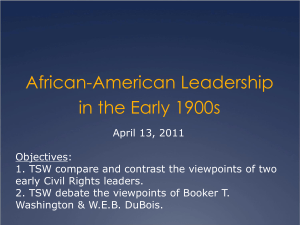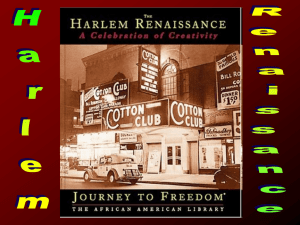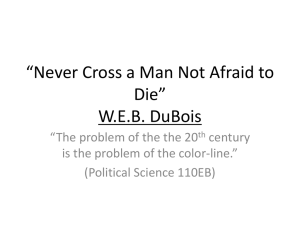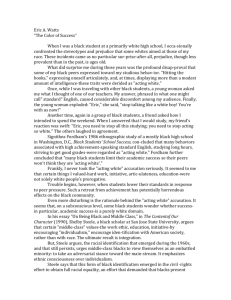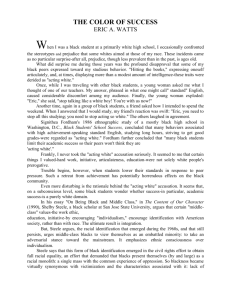Stanley K
advertisement
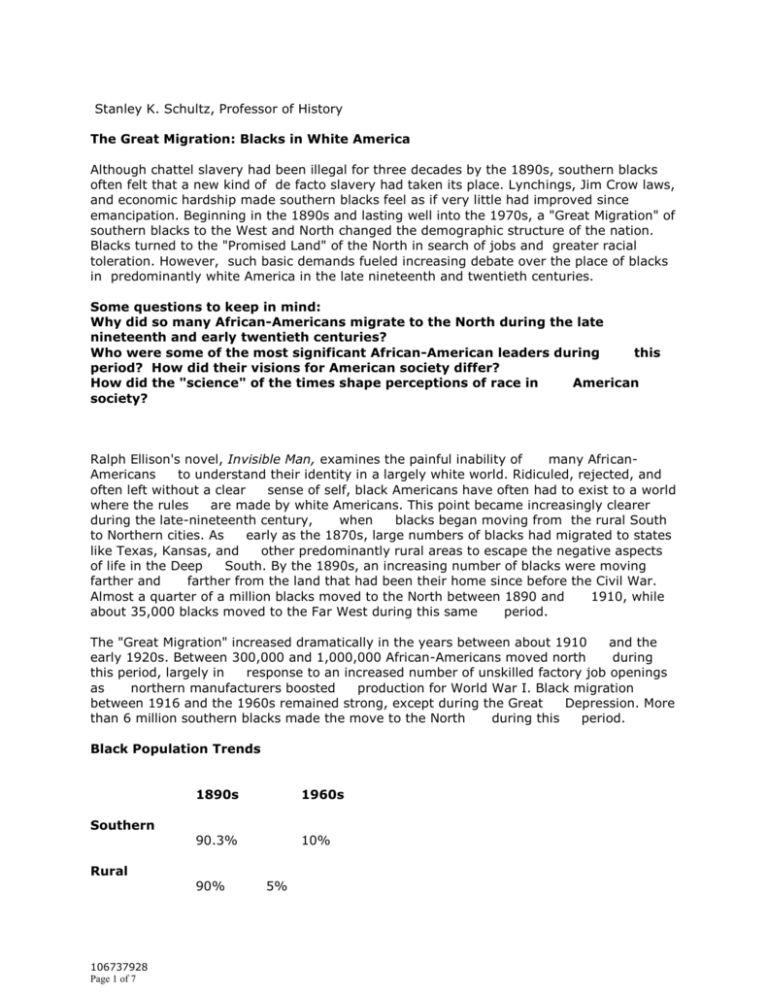
Stanley K. Schultz, Professor of History The Great Migration: Blacks in White America Although chattel slavery had been illegal for three decades by the 1890s, southern blacks often felt that a new kind of de facto slavery had taken its place. Lynchings, Jim Crow laws, and economic hardship made southern blacks feel as if very little had improved since emancipation. Beginning in the 1890s and lasting well into the 1970s, a "Great Migration" of southern blacks to the West and North changed the demographic structure of the nation. Blacks turned to the "Promised Land" of the North in search of jobs and greater racial toleration. However, such basic demands fueled increasing debate over the place of blacks in predominantly white America in the late nineteenth and twentieth centuries. Some questions to keep in mind: Why did so many African-Americans migrate to the North during the late nineteenth and early twentieth centuries? Who were some of the most significant African-American leaders during this period? How did their visions for American society differ? How did the "science" of the times shape perceptions of race in American society? Ralph Ellison's novel, Invisible Man, examines the painful inability of many AfricanAmericans to understand their identity in a largely white world. Ridiculed, rejected, and often left without a clear sense of self, black Americans have often had to exist to a world where the rules are made by white Americans. This point became increasingly clearer during the late-nineteenth century, when blacks began moving from the rural South to Northern cities. As early as the 1870s, large numbers of blacks had migrated to states like Texas, Kansas, and other predominantly rural areas to escape the negative aspects of life in the Deep South. By the 1890s, an increasing number of blacks were moving farther and farther from the land that had been their home since before the Civil War. Almost a quarter of a million blacks moved to the North between 1890 and 1910, while about 35,000 blacks moved to the Far West during this same period. The "Great Migration" increased dramatically in the years between about 1910 and the early 1920s. Between 300,000 and 1,000,000 African-Americans moved north during this period, largely in response to an increased number of unskilled factory job openings as northern manufacturers boosted production for World War I. Black migration between 1916 and the 1960s remained strong, except during the Great Depression. More than 6 million southern blacks made the move to the North during this period. Black Population Trends 1890s 1960s 90.3% 10% Southern Rural 90% 106737928 Page 1 of 7 5% Northern 9.7% 90% Urban 10% 95% Booker T. Washington "Born a slave on April 5, 1856, in Franklin County, Virginia, Washington, whose father is believed to have been white, was taken by his mother, with her two other children, to Malden, near Charleston, West Virginia, after the emancipation. There, poverty necessitated his working from the age of nine, first in a salt furnace and then a coal mine. He attended a school for Negroes where he identified himself as Booker Washington, only later to learn that his mother had named him Booker Taliaferro; he ultimately combined all three names. Having always been eager to acquire an education, he went to the Hampton Normal and Agricultural Institute in Virginia in 1872, and there studied for three years, working as a janitor to pay his expenses....The founding of Tuskegee Institute, a Negro normal and agricultural school in Tuskegee, Alabama, in 1881, and the choice of Washington as its first principal, began his major career....A staunch believer in industrial training for Negroes rather than liberal-arts education, he was shunned by many black intellectuals, notably W. E. B. Du Bois, who saw in his philosophy the guarantee of continued Negro servility...." Source: Webster's American Biographies , G&C Merriam Co., 1975. Booker T. Washington (1856-1915) and family Copyright 1997 State Historical Society of Wisconsin "The wisest among my race understand that agitation for social equality is an extremist folly. It is important and right that all privileges of the law be ours but it is vastly more important that we be prepared for the exercise of those privileges." --Booker T. Washington, speech at the Atlanta Exposition, 1895 W. E. B. Du Bois "Born in Great Barrington, Massachusetts, on February 23, 1868, W. E. B. Du Bois was of African, French, and Dutch ancestry. He was educated at Fisk and Harvard universities and soon after obtaining his Ph.D. at Harvard in 1895 joined the faculty of Atlanta University, where he taught economics and history from 1897 to 1910 and edited the Atlanta University Studies , 1897-1911. With his Souls of Black Folk in 1903 he announced the intellectual revolt against the accomodationist principles of Booker T. Washington that crystallized two years later in the founding, under Du Bois's leadership, of the Niagara Movement. When this group was merged with the newly founded National Association for the Advancement of Colored People (NAACP) in 1909, Du Bois became editor of the association's journal, Crisis , holding the post until 1932....A thorough scholar and an eloquent public speaker, Du Bois became and remained an influential and profoundly inspiring figure among blacks in the United States and abroad....During the 1940s Du Bois began a move from nonideological radicalism toward a Marxist and pro-Soviet viewpoint; this change culminated in his joining the Communist party in 1961...." Source: Webster's American Biographies , G&C Merriam Co., 1975. 106737928 Page 2 of 7 Dr. Du Bois at his desk at Atlanta University where he initiated and edited the famous Atlanta University Studies on Negro Americans Copyright 1997 State Historical Society of Wisconsin "By every civilized and peaceful method we must accords to men." --W. E. B. Du Bois Dubois strive for the rights which the world on Booker T. Washington Marcus Garvey "Born on August 17, 1887, in St. Ann's Bay, Jamaica, Garvey was largely selfeducated and began working as a printer's apprentice at fourteen. He moved to Kingston three years later and became foreman of a large printing company. Blacklisted after leading the employees in a strike for higher wages, he worked briefly for the government printing office, founded two nationalistic publications and a political club, and then sought more lucrative employment in South America. He observed the poor working conditions in many countries and, continuing on to London in 1912, met and assisted an Afro-Egyptian scholar, learning much of Negro history and culture in the course of his work. He returned to Jamaica in 1914 and founded the Universal Negro Improvement Association (U. N. I. A.) and the African Communities League. Marcus Garvey (1887-1940), head of U. N. I. A. Copyright 1997 State Historical Society of Wisconsin In 1916 he moved to New York City, establishing the headquarters of U. N. I. A. there and founding branches during 1919-1920 in nearly every urban area of the country where there was a substantial black population. He also founded the Negro World , the weekly U. N. I. A. newspaper, which continued from 1919 to 1933....[He urged] that black men accept a black Deity, exalting African beauty, expounding on the lives and notable achievements of Negroes throughout history, and projecting plans for Negroes to resettle in Liberia in a "back to Africa" movement. He began several enterprises, including the Black Star Steamship Line and the Negro Factories Corporation, financed by the sale of stock to U. N. I. A. members. Much of his traveling became promotional; he declared that black-owned, black-operated ventures would rebuild the confidence of Negroes in their own people and prepare them for economic independence. Throughout this time he was harassed by both white and black members of middle-class society....In 1925 he was convicted of fraud in connection with his handling of the funds of the Black Star Line, which had gone bankrupt. He was sentenced to five years' imprisonment, but his sentence was commuted by President Calvin Coolidge and in 1927 he was released and immediately deported to Jamaica...." Source: Webster's American Biographies , G&C Merriam Co., 1975. "Up you mighty race! You can accomplish what you will! The negro of yesterday has disappeared from the scene, and his place is taken by a new negro who stands erect, conscious of his manhood rights, fully determined to preserve them at all costs." -- 106737928 Page 3 of 7 Marcus Garvey The future of a nation does not create itself but must in fact be created. Leaders are people who take the initiative to alter the path a country takes by such leaders like W.E.B. DuBois and Booker T. Washington who took the first step in the battle against racial prejudice. These visionaries founded organizations such as the NAACP that involved ordinary citizens who were working for a common goal. However, these leaders were not the only ones who wanted a better life. Others such as the millions of blacks who participated in the Great Migration were also striving for a better future. Many Americans look upon the Harlem Renaissance as a time where blacks created a new class of literature, music, and art. Rarely do they recognize those people who made this venture into a new era possible. Aspects of a Better Future Economy Education Equality The Great Migration Between the turn of the century and 1930, more than 1 million black southerners set out on one of America's most important mass movements. These people migrated from the South's countryside to the cities in the North. They hoped to find better jobs, a new sense of citizenship, and a new respect for themselves, their families, and their people in the North. In 1910 the North and the South were so dissimilar that they could have passed for two different countries. The southern states were isolated, economically backward, had fewer schools, and higher rates of illiteracy. Their northern counterparts boasted cultural attractions and booming industries. Many blacks used the path to the north as an escape route from the menacing racism of the South. Racial segregation was the norm, and blacks were restricted to "colored" facilities that were inferior to the ones marked "white." Black southerners were also politically powerless and were terrorized by whites. From the last decade the 19th century through the first of the 20th century, more black people were lynched than in any other period of American history. Other circumstances also drew black people away from the rural South. New farm machinery was created which could perform the field work, that had once been done by hand, faster and more efficiently. This pushed thousands of poor tenant farmers off the land and toward the city. In 1915, a severe boll weevil infestation destroyed millions of acres of cotton along with the jobs of those who raised it. New machinery and the boll weevil pushed the blacks away from the South, and World War I pulled the blacks toward 106737928 Page 4 of 7 the north. In 1914, the war prevented European laborers from emigrating to the United States, so northern industries turned to the South for workers. Recruiting scouts were sent to the South and they found that recruiting was an effortless task. There was never a shortage of volunteers. Many agents found it easy to take advantage of these willing workers. They insisted that laborers sign harsh and unfair labor contracts which required back breaking work and yielded poor pay. Not surprisingly, the Great Migration had a big impact on the South. Civil rights spokesperson W.E.B. DuBois regarded the mass movement as the end of the South's old order of black oppression and black compliance with racism. Southern gentleman took a bleak view of the Great Migration. "I do not know how the South could live without Negro labor," wailed a Georgia plantation owner. "It is the life of the South; it is the foundation of its prosperity...God pity the day when the Negro leaves the South." Progressive southern employers tried to halt the migration by promising better pay and improved treatment. Other planters tried to keep black workers by intimidation. Attentive whites sometimes boarded northbound trains to attack black men and women and forcibly return them to towns of origin. When moving North, southern migrants did not forget to bring along their culture which subtly changed the environment of the northern cities. Songs and art which personified the Harlem Renaissance came with the Great Migration. Restaurants opened with southernstyle menus, and southern foods appeared in black-owned groceries. For most migrants, the North was no paradise. As in the South, segregation in housing and hiring were the norm, and northern racism sometimes took on a brutality that equaled anything in Mississippi or Alabama. Most often, new arrivals could land only the poor paying jobs that did not require and intelligence: janitor, elevator operator, domestic and unskilled labor. But despite the challenges, most of those who went North never never returned to the South. They preferred to forget the place where they had known so much humiliation and suffering. Booker T. Washington Booker T. Washington was born on April 5, 1856, as a slave, on a plantation in Franklin County, Virginia. When Booker was nine years old, the Civil war broke out in the South. After the war, President Abraham Lincoln ordered all slaves to be freed. In 1872, Booker attended a special school called the Hampton Normal and Agricultural Institute in Hampton. After he graduated in the June of 1875, he worked as a teacher at a black school in Malden, Virginia. In May 1881, Booker accepted a job to run a school for black students in a small town called Tuskegee. Booker found a location for the school in an old church building and later named it the Tuskegee Institute. In 1895, Washington delivered a memorable speech at the Atlanta Cotton States and International Exposition. There, he called a "separate but equal" approach to the races. Unfortunately, on November 14, 1915, Booker T. Washington passed away. Though Booker was gone, his philosophies remained. His main ideas were to get economic equality among the blacks and whites and to get better relations between 106737928 Page 5 of 7 them. He accepted segregation and believed that whites would eventually gave blacks equal rights. W.E.B. DuBois W.E.B. DuBois was raised in the North, the son of free blacks who had never known the mental torture of slavery. Subsequently as DuBois grew up he never felt inferior because of his race, in fact, he was very well respected by the whites in his home town. He became a self-confident young man who believed in the equality of black and white people. DuBois was very intelligent and went to Fisk University, received a PhD from Harvard and studied in Berlin. He strongly believed that at the basis of the racial problem was ignorance. So DuBoise sought to educate all of those who unaware of the problems that race prejudice caused. One of his first studies, "The Philadelphia Negro," in which he personally interviewed twothousand people helped uncover the truth of the black condition. He used this as a tool in the battle against race prejudice. With this approach, DuBois was only reaching intellectuals, he needed more influence. He finally gained vast influence when he helped form the NAACP and became the editor of their publishing arm, The Crisis He had a massive load of work to do; to fix what he considered the problem of the color line, he needed to overcome the problems of his times. Some of these problems included the Supreme Court overturning Civil Rights Bill yet upholding "Separate but Equal" in Plessy versus Ferguson. Booker T. Washington was preaching that blacks should not strive for equality but be satisfied as housekeepers and janitors. DuBois spoke out against all of these things and gave the people who read his work new hope. Without the efforts of DuBois against racism, The Harlem Renaissance could have never occurred. DuBois himself loved living in Harlem during The Renaissance despite the trials that blacks were put through during the times. NAACP Formed on Abraham Lincoln's 100th birthday on February 12, 1909, the National Association for the Advancement of Colored People (NAACP) is an organization founded by such people as W.E.B. DuBois and Mary White Ovington who believed that racial equality should be given not earned. The rights that the NAACP fought for were a legal judicial system, the right to vote, equal employment, schooling, and equal opportunity. Unlike one of their main targets for legal prosecution, the Ku Klux Klan, the NAACP believed in solving their disputes through the court system. Another task that the NAACP was set upon completing was the education of all on the problems and barriers that race prejudice creates. By publishing a monthly magazine called The Crisis the NAACP helped enlighten hundreds of thousands of people about race prejudice. This periodical included stories 106737928 Page 6 of 7 about the problems that blacks faced in everyday life. With the new found knowledge the people were more motivated to act as a community instead of hide as one. The NAACP did not only help create a community of blacks willing to battle for the rights they were born with, it helped bring down those who advocated the concept of segregation and racial superiority. A Story From the Crisis A Negro's Rent Summarized by Tim Gifford In the past blacks have been shunned from renting houses owned by whites. Blacks were rarely able to rent a house that was in a white neighborhood, but if landlords needed money or wanted revenge on the surrounding whites he would permit a black tenant. This racial dispute among houses and money continued for years. Around 1900 the price to rent a house in the city dropped to a extreme low and houses became empty because of the drop in demand. White landlords decided that they would either maintain their own house or leave it vacant rather than rent it out to a black. During this time the racism among tenants was very high and intense. One specific incident that occurred among this time was in a white neighborhood that had and empty house on the black and was rented out to a black family. Many surrounding whites moved immediately, but the ones that stayed in the neighborhood were granted a lower rent payment than before. The blacks that rented the house had to pay more than the whites that lived on the same block. The houses directly on each side of the house occupied by blacks had a huge decrease in pay as well. This example shows how the racism among tenants created many problems and inequalities. Today blacks are able to rent houses in one of the best neighborhoods in the city. Blacks are even paying less than the whites to rent houses that are of the same value. In Harlem the problem has diminished and equality among tenants of different races continues. Links Harlem Harlem Reniassance W.E.B. Dubois Insitute The Story of the NAACP NAACP 106737928 Page 7 of 7
